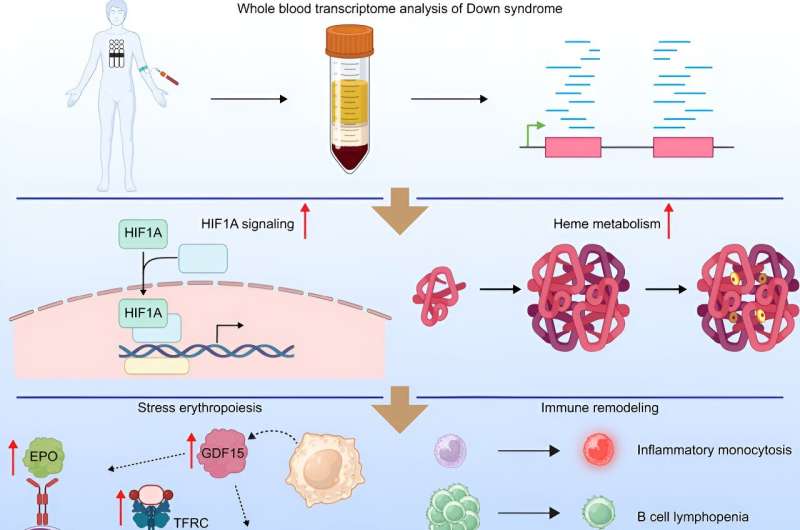This article has been reviewed according to Science X's editorial process and policies. Editors have highlighted the following attributes while ensuring the content's credibility:
fact-checked
peer-reviewed publication
trusted source
proofread
New research discovers differences in oxygen physiology in people with Down syndrome

A new study published in Cell Reports by researchers from the Linda Crnic Institute for Down Syndrome (Crnic Institute) at the University of Colorado Anschutz Medical Campus reports important differences in oxygen physiology and red blood cell function in individuals with Down syndrome.
The study is part of the ongoing Human Trisome Project, a large and detailed cohort study of the population with Down syndrome, including deep annotation of clinical data, the largest biobank for the study of Down syndrome to date, and multi-omics datasets.
The Crnic Institute team first analyzed hundreds of blood samples to identify physiological differences between research participants with Down syndrome versus controls from the general population. They observed that triplication of chromosome 21, or trisomy 21, the chromosomal abnormality that causes Down syndrome, leads to a physiological state reminiscent of hypoxia, or low oxygen.
They identified major changes in gene expression indicative of low oxygen availability, including induction of many hypoxia-inducible genes and proteins, as well as increased levels of factors involved in the synthesis of heme, the molecule that transports oxygen inside red blood cells.
"These results reveal that hypoxia and hypoxic signaling should be front and center when we talk about the health of people with Down syndrome," says Dr. Joaquín Espinosa, executive director of the Crnic Institute, professor of pharmacology, principal investigator of the Human Trisome Project, and one of the senior authors of the paper.
"Given the critical role of oxygen physiology in health and disease, we need to understand the causes and consequences of hypoxia in Down syndrome, which could lead to effective interventions to improve oxygen availability in this deserving population."
"The results are remarkable. It is safe to say that the blood of people with Down syndrome looks like that of someone who was quickly transported to a high altitude or who was injected with erythropoietin (EPO), the master regulator of erythropoiesis, the process of new red blood cell formation," explains Dr. Micah Donovan, lead author of the paper.
"Although it has been known for many years that people with Down syndrome have fewer and bigger red blood cells, this is the first demonstration that they overproduce EPO and that they are undergoing stress erythropoiesis, a phenomenon whereby the liver and the spleen need to start producing red blood cells to supplement those arising from the bone marrow."
The team discovered that these phenomena are also observed in a mouse model of Down syndrome, thus reinforcing the idea that these important physiological changes arise from triplication of genetic material and overexpression of specific genes.
"The fact that hypoxic signaling and stress erythropoiesis are conserved in the mouse model paves the way for mechanistic investigations that could identify the genes involved and reveal therapeutic interventions to improve oxygen physiology in Down syndrome," explains Dr. Kelly Sullivan, associate professor of pediatrics, director of the Experimental Models Program at the Crnic Institute, and co-author in the study.
The study team also investigated whether the elevated hypoxic signaling and associated stress erythropoiesis was tied to the heightened inflammatory state characteristic of Down syndrome. Although individuals with the stronger hypoxic signatures show more pronounced dysregulation of the immune system and elevated markers of inflammation, their results indicate that lowering inflammation does not suffice to reverse the hypoxic state.
"We will need a lot more data to understand what is causing the hypoxic state and its impacts on the health of people with Down syndrome," says Dr. Matthew Galbraith, assistant research professor of pharmacology, director of the Data Sciences Program at the Crnic Institute, and one of the senior authors of the paper.
"The hypoxic state could be caused by obstructive sleep apnea (which is common in Down syndrome), cardiopulmonary malfunction, or even perhaps defects in red blood cell function. We are very excited about several ongoing clinical trials [...] for obstructive sleep apnea in Down syndrome, which we believe will be very informative."
The Crnic Institute study team is already planning several follow-up studies, with the explicit goal of illuminating strategies to improve oxygen physiology in the population with Down syndrome.
"This is another huge breakthrough from our scientists at the Crnic Institute that we hope will lead to additional treatments quickly," says Michelle Sie Whitten, president & CEO of Global Down Syndrome Foundation, a partner and an affiliate organization of the Crnic Institute.
"As a mother of a brilliant 21-year-old with Down syndrome, I am eager to understand how to normalize oxygen physiology safely and how that may improve the lives of millions of people with Down syndrome across the world."
More information: Micah G. Donovan et al, Multimodal analysis of dysregulated heme metabolism, hypoxic signaling, and stress erythropoiesis in Down syndrome, Cell Reports (2024). DOI: 10.1016/j.celrep.2024.114599



















